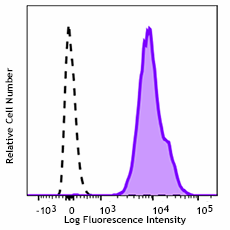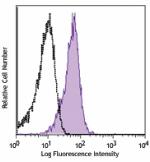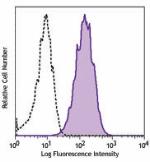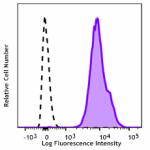- Clone
- RG9-35 (See other available formats)
- Regulatory Status
- RUO
- Other Names
- Lgals9, Gal-9, Ecalectin
- Isotype
- Rat IgG2a, κ
- Ave. Rating
- Submit a Review
- Product Citations
- publications

-

C57BL/6 thymocytes were fixed and permeablized, then stained with anti-mouse Galectin-9 (clone RG9-35) PE/Cyanine7 (filled histogram) or Rat IgG2a, κ PE/Cyanine7 Isotype control (open histogram)
| Cat # | Size | Price | Quantity Check Availability | Save | ||
|---|---|---|---|---|---|---|
| 136113 | 25 µg | $165 | ||||
| 136114 | 100 µg | $375 | ||||
Galectin-9 is a mammalian lectin with a molecular weight of 40 kD that has two conserved carbohydrate recognition domains (CRDs) and forms homodimers. It recognizes N-acetyllactosamine (Galbeta1-4GlcNAc) and T-antigen (Galbeta1-3GalNAc). Tim-3 has been reported as its ligand. Galectin-9 is expressed by lymphocytes, dendritic cells, granulocytes, eosinophils, astrocytes, endothelial cells, fibroblasts, and thymus epithelial cells. It may be retained intracellularly or transported to the cell surface whereby cleavage generates a soluble form. Galectin-9 is involved in events such as cell aggregation, adhesion, chemotaxis, and apoptosis, and is important for the regulation of the immune response. Galectin-9 induces regulatory T cells, and suppresses Th1 and Th17 responses.
Product DetailsProduct Details
- Verified Reactivity
- Mouse
- Antibody Type
- Monoclonal
- Host Species
- Rat
- Immunogen
- Recombinant mouse galectin-9
- Formulation
- Phosphate-buffered solution, pH 7.2, containing 0.09% sodium azide.
- Preparation
- The antibody was purified by affinity chromatography and conjugated with PE/Cyanine7 under optimal conditions.
- Concentration
- 0.2 mg/ml
- Storage & Handling
- The antibody solution should be stored undiluted between 2°C and 8°C, and protected from prolonged exposure to light. Do not freeze.
- Application
-
ICFC - Quality tested
- Recommended Usage
-
Each lot of this antibody is quality control tested by immunofluorescent staining with flow cytometric analysis. For flow cytometric staining, the suggested use of this reagent is = 1.0 µg per million cells in 100 µl volume. It is recommended that the reagent be titrated for optimal performance for each application.
- Excitation Laser
-
Blue Laser (488 nm)
Green Laser (532 nm)/Yellow-Green Laser (561 nm)
-
Application References
(PubMed link indicates BioLegend citation) -
- Fukushima A, et al. 2008. Int. Arch. Allergy Immunol. 146:36. (FA)
- Hou H, et al. 2014. PLoS One. 9:110585. PubMed
- RRID
-
AB_2800640 (BioLegend Cat. No. 136113)
AB_2800640 (BioLegend Cat. No. 136114)
Antigen Details
- Structure
- Homodimer, each chain is a 343 aa protein of 40 kD that has two conserved carbohydrate recognition domains (CRDs)
- Distribution
- Lymphocytes, dendritic cells, neutrophils, eosinophils, astrocytes, endothelial cells, fibroblasts, thymus stromal/epithelial cells
- Function
- Cell aggregation, cell adhesion, chemotaxis, apoptosis, suppression of Th1 and Th17 responses, induction of regulatory T cells
- Ligand/Receptor
- Tim-3
- Bioactivity
- Chemotaxis, apoptosis, cell adhesion
- Cell Type
- Astrocytes, Dendritic cells, Endothelial cells, Eosinophils, Epithelial cells, Fibroblasts, Lymphocytes, Neutrophils, Tregs
- Biology Area
- Apoptosis/Tumor Suppressors/Cell Death, Cell Adhesion, Cell Biology, Cell Motility/Cytoskeleton/Structure, Immunology
- Molecular Family
- Adhesion Molecules, Immune Checkpoint Receptors
- Antigen References
-
1. Klibi J, et al. 2009. Blood 113:1957
2. Seki M, et al. 2008. Clin Immunol 127:78
3. Tsuboi Y, et al. 2007. Clin Immunol 124:221
4. Zhu C, et al. 2005. Nat Immunol 6:1245
5. Dunphy JL, et al. 2002. J. Biol. Chem. 277:14916 - Gene ID
- 16859 View all products for this Gene ID
- UniProt
- View information about Galectin-9 on UniProt.org
Related Pages & Pathways
Pages
Related FAQs
Other Formats
View All Galectin-9 Reagents Request Custom Conjugation| Description | Clone | Applications |
|---|---|---|
| PE anti-mouse Galectin-9 | RG9-35 | ICFC |
| APC anti-mouse Galectin-9 | RG9-35 | ICFC |
| PerCP/Cyanine5.5 anti-mouse Galectin-9 | RG9-35 | ICFC |
| PE/Cyanine7 anti-mouse Galectin-9 | RG9-35 | ICFC |
| Ultra-LEAF™ Purified anti-mouse Galectin-9 | RG9-35 | ICFC,FA |
| TotalSeq™-B1288 anti-mouse Galectin-9 | RG9-35 | ICPG |
Compare Data Across All Formats
This data display is provided for general comparisons between formats.
Your actual data may vary due to variations in samples, target cells, instruments and their settings, staining conditions, and other factors.
If you need assistance with selecting the best format contact our expert technical support team.
-
PE anti-mouse Galectin-9

Intracellular staining of mouse thymocytes with the RG9-35 P... -
APC anti-mouse Galectin-9

C57BL/6 mouse thymocytes were fixed, permeabilized and then ... -
PerCP/Cyanine5.5 anti-mouse Galectin-9

C57BL/6 mouse thymocytes were fixed, permeabilized and then ... -
PE/Cyanine7 anti-mouse Galectin-9

C57BL/6 thymocytes were fixed and permeablized, then stained... -
Ultra-LEAF™ Purified anti-mouse Galectin-9
-
TotalSeq™-B1288 anti-mouse Galectin-9
 Login/Register
Login/Register 












Follow Us